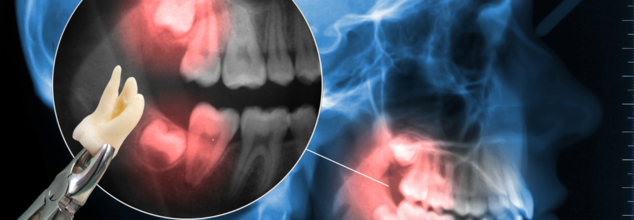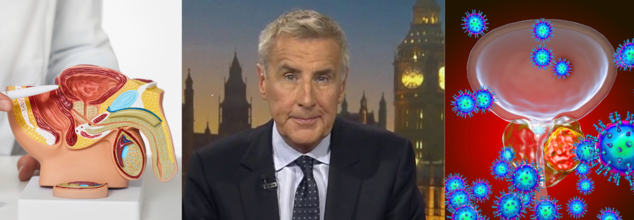- Health Conditions A-Z
- Health & Wellness
- Nutrition
- Fitness
- Health News
- Ayurveda
- Videos
- Medicine A-Z
- Parenting
- Web Stories
When Is It The Right Time To Get Your Wisdom Tooth Extracted?

Credits: Canva
As you grow older, a lot of things change in your body. Your body grows and develops. While some of these changes could be smooth, other transitions could create a bit of turmoil. One such is wisdom tooth.
What Is A Wisdom Tooth?
As per the National Library of Medicine, wisdom teeth come in at the very back of our mouth, with one at the end of each row of teeth. They usually do not fully develop until ages 18 to 24. This is when they appear and are commonly known as "troublemakers". This is because often in our jaws, there is not enough space for these teeth, and so it can cause pain when it comes out.
Often the growth of wisdom tooth could lead to pain and inflammation and thus, removal would be necessary.
Historically, wisdom tooth date back to our distant ancestors who had larger jaws and thus had more teeth. However, as time wet by and with evolution and changing eating practices, the jaws have shrunken and are thus too small for some people to accommodate the "extra" teeth. However, this does not mean that it causes problems for everyone. For many, these teeth can easily settle in.
The percentage of wisdom teeth extracted in women is significantly higher than men, this is because women often consult more often consult more than men, as is also noted in a 2021 study published in Annals of Medicine & Surgery, titled: The wisdom behind the third molars removal: A prospective study of 106 cases.
Another study published in the Journal of Oral Rehabilitation from 1987 also notes that women have a smaller maximum jaw opening than men. This could also be the reason why women need to get their wisdom tooth extracted more often than men.
What Are The Signs That Tell You To Extract Your Wisdom Tooth?
If you have these signs, you may want to consider extracting your wisdom tooth
Wisdom Tooth Impaction
This is when the third molars grow without fully emerging through your gums. This happens when they grow at an odd angle and emerge crooked, and cause further damage to the other healthy neighboring teeth. The impacted wisdom tooth could often grow at 180 degrees in the wrong direction into the jaw, and thus cause oral infection, jawbone cysts, and gym disease.
Gum Inflammation
This happens when food, plaque, and bacteria get underneath your gum tissue. Swollen or inflamed gums are often the first signs of wisdom tooth impaction.
Stiff Jaw
If you witness your jaw being stiff, then this could be because your wisdom tooth is pressing against your other teeth.
Jaw Pain
This could also happen when your wisdom tooth is impacted and thus you face pain in your jaw, especially while you try to open your mouth.
Persistent Bad Breath or Taste In Your Mouth
Despite brushing and following all the oral hygiene routine, you still experience bad breath, it could be because wisdom tooth have caused decay to your adjacent teeth.
So, When Should You Remove It?
If you face any of these signs, it is best to see your dentist and consult with them before you go ahead with an extraction surgery. Furthermore, the American Dental Association notes that you may need to have your wisdom tooth taken out, if you have:
- Pain in or near your wisdom teeth.
- Repeated infection of soft tissue behind the lower last tooth.
- Fluid-filled sacs called cysts.
- Tumors.
- Damage to nearby teeth.
- Gum disease.
- Widespread tooth decay
Is It PMS Or Pinot? Why You Might Be Craving A Drink More Before Your Period

Credits: Canva
Lately, I've seen something strangely consistent in my circle of girlfriends, the sudden need to open a glass of wine, and not any day, but just when our periods are about to come. We'd tease about it, "Is it PMS or Pinot?" but beneath the joke, there was a common reality, we were all grabbing a drink with more frequency during that pre-period stage. It seemed emotional, reckless, and oddly ritualistic.
At first, I attributed it to stress or coincidence. But one by one, the same pattern repeated among my friends: irritability, cravings for food, and yes, for even more potent-than-usual alcohol cravings several days prior to menstruation. It wasn't about being tipsy — it was about calming something deeper.
And now, science has finally caught up with what we’ve been quietly experiencing for years. A recent study confirms that our hormones — especially that cocktail of high estrogen and low progesterone before ovulation may actually heighten our alcohol cravings. It’s not all in our heads after all. It’s biology.
Reading that was a moment of truth. It was satisfying to understand that what we felt wasn't weakness or insufficient willpower, but a true, hormonal change influencing our brain's reward system. This study has opened the door to knowing our bodies better and to finally showing ourselves a little grace rather than guilt.
Because if our hormones are manning the bar, maybe it's high time we spoke with our biology before we beat up on ourselves for that second glass of wine.
For most women, the pre-period days bring a familiar mix of symptoms—bloating, moodiness, exhaustion, and cravings. But with chocolate or chips, have you ever caught yourself grabbing for a glass of wine or wanting a cocktail more than you usually do? Science may now have an explanation.
A pilot study recently shown at the Research Society on Alcohol's annual conference in New Orleans has shed new light on the relationship between the menstrual cycle and alcohol craving. The researchers discovered that shifts in hormones at some points during the cycle, when estrogen is high and progesterone is low, might raise the risk of alcohol craving and even binge drinking.
The research, conducted under the leadership of Layne Robinson, doctoral student in clinical psychology at the University of Kentucky, involved 61 women between the ages of 21 and 35 who drank alcohol two or more times a week. Participants completed daily self-reports of alcohol consumption and craving, as well as saliva and urine samples to monitor hormone levels and ovulation.
Research indicated that women tended to crave alcohol when they were in their late follicular phase, which is right before ovulation. When this happens, levels of estrogen (estradiol, in particular) increase while progesterone is low.
"We do know that rises in estradiol, the most potent of the estrogens, can modify the activity of dopamine in the brain," Robinson stated. "These modifications to dopamine neurotransmission increase sensitivity to reward, which is one of the main mechanisms of substance craving and use."
This implies that women might be more biologically susceptible to cravings and impulsive behaviors—such as drinking—during this stage of their menstrual cycle.
Can Drinking During Your Period Make PMS Worse?
While a glass of wine may be the ideal remedy for period stress, it may be causing more harm than good. Alcohol can affect hormone levels by stimulating estrogen and testosterone release. These spikes can make PMS symptoms worse, such as mood swings, anxiety, and irritability.
Alcohol also impacts the balance of prostaglandins—hormone-like substances that control inflammation and pain. In its disturbed state, they can heighten menstrual cramps. Indeed, alcohol is a diuretic, which causes more urination and may lead to dehydration—a primary cause of cramping and bloating.
Heavy or chronic drinking may even disrupt your cycle completely. Alcohol, when used regularly, upsets the delicate estrogen-progesterone balance required for ovulation and menstruation. This may result in abnormal periods or even amenorrhea (no menstruation). When couples are trying to conceive, the effect of alcohol on hormone balance can increase the chances against conception.
Alcohol also affects how your body handles menstrual blood. When you drink and become dehydrated, blood and mucus can thicken, which may make periods more painful.
Why You Need Alcohol During Menstruation?
One of the strongest theories from Robinson's research is about dopamine—the brain's pleasure neurotransmitter. Estradiol is said to enhance dopamine activity, making the brain's reward response more heightened.
"Estradiol and alcohol consumption have been shown to rise when estradiol levels are high and progesterone levels are low," Robinson explained. As dopamine levels surge, our brain is more sensitive to rewards—and alcohol, a substance that releases dopamine, is particularly enticing.
This link may be why, on the eve of ovulation, you might catch yourself suddenly craving not only sweets or salty treats, but a glass of wine or a cocktail.
Should You Totally Avoid Alcohol Before Your Period?
While the occasional drink is usually fine, women need to understand how the cycle can impact drinking. If you realize that you're going to want to drink more in a specific phase, you can make better-informed decisions to limit risk.
Robinson points out that knowledge of "risky" times for alcohol craving may assist women in taking preventive measures, i.e., keeping away from places where alcohol is easily found, or scheduling other activities such as physical exercise or social gathering without alcohol.
Medications that stabilize hormones could also someday be used as part of treatment for alcohol use disorders in women, but more studies need to be conducted before these therapies become the norm.
Managing Period Cravings the Healthy Way
If you are attempting to reduce alcohol intake—particularly while you're on your time—it's beneficial to control cravings with food and lifestyle habits:
Lean protein: Regulates blood sugar and makes you feel full longer
Complex carbs: Whole grains, lentils, and legumes can leave you feeling full and curb sugar cravings
Hydration: Increased water intake can curb cramps and decrease bloating
Food high in nutrients: Dairy, leafy greens, and fortified foods can restore important nutrients such as calcium, magnesium, and iron
Vitamins: B vitamins, Vitamin D, and Vitamin E have been shown to assist with mood and cravings in PMS
Exercise: Routine physical activity increases endorphins and lessens tension, allowing you to better cope with hormonal changes
Robinson's work fills a crucial part of our knowledge about women's health: cravings and drug use patterns might not be all about behavior—they're also physiological. Although more research is required to understand the connection between estrogen, dopamine, and drinking, initial findings indicate that understanding your body's hormonal cycles can guide you to make better, healthier decisions.
The next time you crave a Pinot just before your period, take a moment to ask yourself- is it really you, or are your hormones speaking?
Fact Check: Can Scorpion Venom Really Treat Cancer?

Credits: Canva
Of the many bizarre things you may have heard, at the FAPESP Week France, researchers at the University of Sao Paulo presented their study findings stating that scorpion venom could help treat breast cancer.
What Is The Study All About?
The researcher found that a molecule which is present in scorpion venom could act similarly used in that of the chemotherapy drug, which could then kill cancer cells.
The molecule is called BamazScplp1, found in the venom of Brotheas amazonicus scorpion. It showed cancer-fighting properties when tested in lab.
"Through bioprospecting, we were able to identify a molecule in the species of this Amazonian scorpion that is similar to that found in the venoms of other scorpions and that acts against breast cancer cells," said Eliane Candiani Arantes, a professor at the university and the project's coordinator.
How Was The Study Conducted?
The researcher used a process called heterologous expression, which allowed them to produce the required toxin content for the study. In this process, the gene that produces this particular protein was inserted in another organism, most often, this is usually yeast or bacteria and then later produced in large quantities inside the lab.
"We also intend to obtain these molecules through heterologous expression," said Ms Arantes."Our idea now is to obtain this serine protease through heterologous expression [in a fragment or complete gene from a host organism that doesn't have it naturally] in Pichia pastoris," she added.
Tests on breast cancer cells showed that the peptide produced a response similar to paclitaxel, a widely used chemotherapy drug for treating the disease.
"The peptide induces cell death mainly through necrosis, an action similar to that of molecules identified in other scorpion species," the study highlighted.
Have There Been Similar Findings Before?
In a 2017 study, titled Scorpion and spider venoms in cancer treatment: state of the art, challenges, and perspectives, it was revealed that animal venoms do comprise a mix of bioactive molecules with high affinity for multiple targets in cells and tissues.
The study used scorpion and spider venoms and purified peptides that exhibit "significant effects on cancer cells". It led to four potential mechanisms: induction of cell cycle arrest, growth inhibition and apoptosis; inhibition of angiogenesis; inhibition of invasion and metastasis; and blocking of specific transmembrane channels.
The study noted: "Cancer is a considerable global contributor to disease-related death. Despite some advances being made, therapy remains palliative rather than curative for the majority of cancer indications. Consequently, more effective therapies need to be devised for poorly responding cancer types to optimize clinical cancer management. Scorpion and spider venoms may occupy a role in the development of improved anti-cancer modalities."
Another study published in 2013, titled Two peptides, TsAP-1 and TsAP-2, from the venom of the Brazilian yellow scorpion, Tityus serrulatus: Evaluation of their antimicrobial and anticancer activities, noted that scorpion venom contains a mixture of biological chemicals called peptides, some of which are known to trigger cell death by forming pores in biological membranes, as also reported in The Conversation. Cell death can be useful if we are able to target, say, tumour cells to auto-destruct.
These toxins can have very potent effects. For instance, one particular small peptide, known as TsAP-1, isolated from the Brazilian yellow scorpion (Tityus serrulatus), has both anti-microbial and anti-cancer properties.
Ex-Sky TV Presenter Dermot Murnaghan Reveals Stage 4 Prostate Cancer

Credits: Canva and SKY News
Veteran journalist and broadcaster Dermot Murnaghan has revealed that he has been diagnosed with stage 4 prostate cancer.
The 67-year-old, known for anchoring major news shows across ITV, BBC, and Sky News, shared the news on social media. He also added that he is currently feeling well and responding positively to treatment.
Murnaghan wrote on X (formerly Twitter), “Some personal news… I’ve been diagnosed with Stage IV advanced prostate cancer.”
He added, “I’m fortunate to have a simply outstanding medical team looking after me, who I can’t thank enough—they are administering the best possible care with expertise, compassion and sensitivity.” He also shared his gratitude for the "monumental love and support" he’s received from his wife, family, and close friends.
Drawing From Personal Experiences To Raise Awareness
Murnaghan used his post to raise awareness about prostate cancer and called on men, especially those over 50 or in high-risk groups, to get themselves tested. “Early detection is crucial,” he wrote. “And be aware, this disease can sometimes progress rapidly without obvious symptoms.” He also voiced his support for routine prostate cancer screening through the NHS.
Despite his diagnosis, Murnaghan said he hopes to take part in the upcoming Tour De 4 charity bike ride in Glasgow this September. The event is organized by Olympic cycling champion Sir Chris Hoy, who also has prostate cancer. The ride aims to challenge public perceptions about living with stage four cancer and show that many people continue to lead active, fulfilling lives even while undergoing treatment.
Life of Dermot Murnaghan
Dermot Murnaghan has had a long and respected career in British media. He began his journalism journey at Channel 4 News and later anchored ITV’s The Big Story, News at Ten, Evening News, and Nightly News through the 1990s and early 2000s. In 2002, he moved to the BBC, where he became a familiar face on BBC Breakfast, the Six O'Clock News, and the Ten O’Clock News. From 2003 to 2014, he hosted the popular BBC quiz show Eggheads. He joined Sky News in 2007, where he remained a leading anchor until 2023.
In addition to his news broadcasting, Murnaghan has presented true-crime documentary series such as Crimes That Shook Britain and Killer Britain. He also currently hosts a podcast called Legends of News, where he speaks with experienced journalists about some of the most significant stories they've covered.
What is Prostate Cancer?
Prostate cancer affects the prostate gland, a small walnut-sized part of the male reproductive system located just below the bladder. It is most common in older men, particularly those over 75. Risk factors include age, family history, and ethnicity, with black men facing a higher risk.
Symptoms can include frequent urination (especially at night), difficulty starting or stopping urination, weak urine flow, and blood in urine or semen. However, some cases progress without noticeable symptoms.
Stage 4 prostate cancer means the disease has spread to other parts of the body. While outcomes vary, around half of men diagnosed at this stage live for five years or more, according to Cancer Research UK.
Murnaghan’s message is clear: awareness and early testing can make all the difference.
© 2024 Bennett, Coleman & Company Limited

